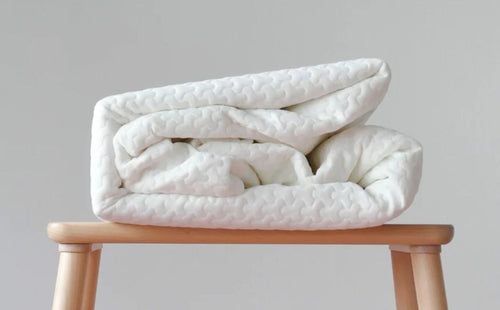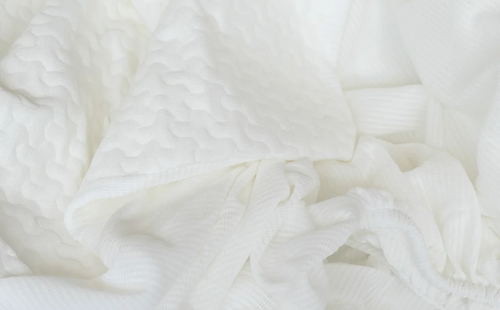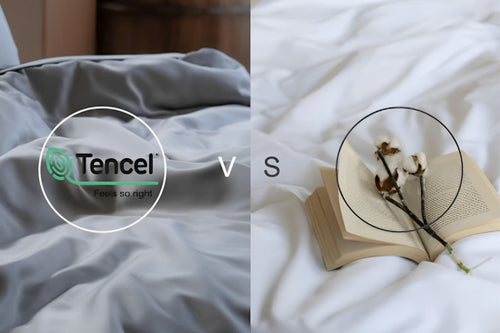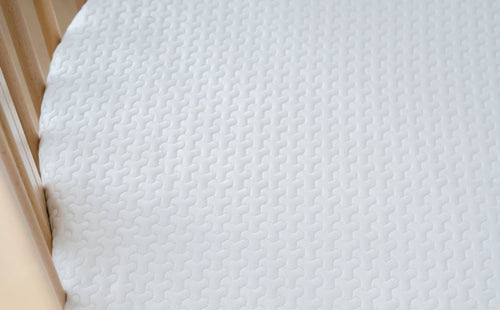At A Glance
Find out what to look for when picking a mattress protector. Learn about the benefits, types, and key features to help you make the right choice.
Quick Tips
- Always choose a mattress protector that fits snugly.
- Wash your protector regularly to maintain cleanliness and hygiene.
- Look for OEKO-TEX® certification for safer materials.
With so many things to manage in a day, you shouldn't scrimp on a good night’s sleep. As such, investing in quality bedding nowadays can be expensive, with top-tier mattresses often costing thousands of dollars.
Fitted sheets can protect your bed against spills and dust on the surface, but they still leave your bed vulnerable to accidents. You could knock your coffee cup on the bed, or your kids could accidentally wet the bed in the middle of the night. To extend the life of your bed in the long term, it's a good idea to buy a mattress protector sheet.
But what is a good mattress protector? From how to choose one to where to buy mattress covers in Singapore, read this buying guide to find the answers.

Image By Jean Van Der Meulen From Pexels
Table Of Contents
|
What Are The Benefits Of Mattress Protector? |
|
What Type Of Mattress Protector Is Best? |
|
Key Considerations When Choosing A Mattress Protector |
|
What Is The Difference Between Mattress Protector, Mattress Pad & Mattress Topper? |
|
How Do I Know What Size Mattress Protector I Need? |
|
Frequently Asked Questions |
|
Conclusion |
What Are The Benefits Of Mattress Protector?
Before buying a mattress protector, you've probably asked yourself, "What is a mattress protector anyway?" or “Do I really need one?”
Well, the short answer is yes! Here are some mattress protector benefits that will leave you wondering why you haven’t discovered it sooner.
Maintain Cleanliness
As the name suggests, its primary purpose is protection. A high-quality waterproof mattress protector safeguards your bed from spills, urine, and sweat. It prevents liquids from seeping into your bed, making cleaning as simple as removing and washing the protector.
Keep Allergies At Bay
Naturally, you wouldn’t want to come home after a long day and sleep on a bed that makes you sneeze. Another mattress cover benefit is that it prevents dust mites, dampness, and other irritants from penetrating your bed.
Preserve Warranty
When you purchase a mattress, certain issues such as dampness, mould, normal wear and tear, discolouration, and natural odours aren’t covered by the warranty. That’s why it’s a great idea to protect your bed with a high-quality protector sheet. It will keep your sleeping environment safe for a long time, ensuring your investment is protected and your warranty remains valid.

Image By Tatiana Syrikova From Pexels
What Type Of Mattress Protector Is Best?
Mattress protectors vary in how these are secured to the bed, catering to different needs and preferences:
Elastic Strap
Best for: Easy setup
If you're unsure how to put on a mattress protector, try using the one with an elastic strap. As the easiest type of mattress shield to set up, simply hook the stretchable bands under the corners of the bed. With their thick and fluffy covering, elastic strap protectors also double as bed toppers, softening the overall feel of your bedding.
Fitted Sheet
Best for: Easy laundering
A fitted sheet mattress cover suits those who enjoy the benefits of fitted bedsheets. Thanks to their elastic corners, these covers fit snugly into their respective bed sizes while being easy enough to remove for laundry and maintenance.
Featuring Weavve's Mattress Protector With Fitted Sheet Design
Full Encasement And Zippered Protection
Best for: Full protection
A full-encasement cover provides extensive protection suitable for any sleeper, making it an excellent choice as a kid or toddler mattress protector. The mattress is placed inside a zippered enclosure, keeping your entire bed safe and secure.
This type of lock can make the bed cover hard to remove for laundering, but with its comprehensive protection, you can rethink how often to wash your mattress protector entirely.

Image By Ketut Subiyanto From Pexels
Key Considerations When Choosing A Mattress Protector
Material
Many benefits of bed protectors are determined by the material used. Some common fabrics consist of:
Cotton
Cotton is a popular choice for mattress toppers because it is a soft and breathable material. It is also lightweight, reasonably durable depending on thread count, and easily washable.
Since cotton is widely accessible and versatile, this material comes in many variants and price ranges. However, the process of creating cotton and converting these into cotton bedsheets is resource-intensive and exposes the fabric to various chemicals.

Image By Ylanite Koppens From Pexels
Bamboo
With the rise of eco-friendly fabrics, bamboo mattress toppers are beginning to rise in popularity. Its chemical structure is what accounts for its buttery smooth finish and hypoallergenic properties, perfect for those with sensitive skin. Bamboo is also inherently antibacterial and moisture-wicking, making maintenance a breeze.

Image By Emre Orkun KESKIN From Pexels
TENCEL™
TENCEL™ takes environmentally friendly materials up a notch. A fabric created from wood chips of eucalyptus trees, TENCEL™ boasts a zero-waste, non-toxic production process, making this a prime choice for those looking for “clean” fabrics for themselves or their loved ones.
Similar to Bamboo, TENCEL™ mattress protectors are antimicrobial, hypoallergenic, and repellant to dust and moisture, making them a top choice for those seeking high-quality mattress protectors.
Its breathable fabric is cool to the touch which makes staying cool during warm nights easy, while its non-wrinkling construction keeps your bed looking new each day with little fuss - both key considerations for a mattress protector in Singapore.
Featuring Weavve’s TENCEL™ Lyocell Mattress Protector
Vinyl & Synthetic Fabrics
Vinyl and other synthetic fabrics have been the backbone of bed covers. These materials are long-lasting and water-repellant thanks to their plastic structure. However, the same tough structure traps heat and makes noise when you move around in your sleep, making for unpleasant nights.
In very hot storage conditions, plastic-based mattress protectors can get brittle, and harmful chemicals found in the creation of plastics such as BPA and other alternatives can hinder children’s normal growth and development over time.
Nevertheless, these variants still remain in the market because of their affordability and reliability in keeping a bed clean.
To summarize each material’s pros and cons:
|
Pros |
Cons |
|
|
Cotton |
|
|
|
Bamboo And TENCEL™ |
|
|
|
Vinyl Or Synthetic |
|
|
Water-Repellency
Since mattress covers must be excellent at protecting your bed from unforeseen spills, features such as “waterproof” or “water-resistant” are practically expected. Both terms denote the cover’s water-repelling capabilities and tend to be used interchangeably, but there are key differences between the two.
A waterproof protector ensures that no liquid will penetrate and reach the mattress regardless of the amount or duration. On the other hand, a water-resistant mattress protector can repel some liquid temporarily, but this may eventually soak through if the spill is substantial or left unattended for too long.
Featuring Weavve’s TENCEL™ Waterproof Mattress Protector
Safety
Since you sleep on your bed every night, it pays to be critical of what you and your loved ones come into close contact with. Dirty mattresses are magnets for bed bugs or even seemingly harmless but common allergens such as dust mites and pet dander.
Cleaning these off a bed, while necessary, can be a strenuous and time-consuming ordeal. As an easy-to-remove layer, a mattress protector serves as anti-allergy protection, enabling you to clean your bed regularly without heavy lifting.
Moreover, toxic chemicals associated with processing textiles can enter your body through your breathing, saliva, or skin, causing adverse effects in the long run. This is especially important for mattress covers, as these stay on the bed—and, by association, your skin—for an extended period of time. Sleep with confidence by looking for an OEKO-TEX® mattress protector. You can easily find this in the product tag.
OEKO-TEX® Certification not only signifies a non-toxic cover but also that your bed protector sheet is made in a way that’s safe, transparent, and socially responsible across all parts of the value chain.

Image By Polina Tankilevitch From Pexels
Longevity
Mattress protectors are meant to protect a long-term investment, so they too must stand the test of time.
The durability of a bed cover depends on its material and construction. For instance, in bedsheets, a higher thread count for natural fabrics such as cotton, bamboo, and TENCEL™ leads to more durable fabrics. For covers, you might want to look into the type of fibres used — whether they are of the finest quality.
Knitting or stitching style also plays a role. Weavve Home's 100% TENCEL™ Lyocell jacquard knit in its outer layer gives the bed protector that durable yet extra comfortable feel.
Maintenance & Aftercare Requirements
Superior construction also needs to be matched with the right maintenance plan. Convenience is a key requirement when you want to buy a mattress cover in Singapore. Thankfully, most of them are machine-washable with cold water and mild detergent.
For covers with synthetic fibres, avoid bleach, as this may damage the plastic material. They can also be tumble dried on low heat settings to ensure they maintain their quality over time. Better yet, abide by the correct wash settings based on the sheets’ care tags.
If you intend to bring home a TENCEL™ Mattress Protector from Weavve Home, here are the care instructions to extend the life of your mattress cover.
Wash At Or Below Sixty Degrees Celsius
This temperature is perfect for laundering your protector sheet. It’s common for people to overlook water temperature when doing laundry, but it’s vital for preserving your sheet’s lifespan. Start paying attention to this detail today to ensure its longevity.

Image By RDNE Stock Project From Pexels
Tumble Dry On Low Temperature
Opt for a low-temperature setting when tumble drying your sheet to avoid damaging its elastic and prevent unnecessary shrinkage.
Avoid Ironing
Exposing your bedding to high levels of heat could damage the material and shorten its lifespan. This is because such harsh conditions may cause the fibres to weaken.
Avoid Dry Cleaning
Like mentioned above, the high temperatures used in dry cleaning machines can damage the fabric. Give your covers tender-loving and proper care to make them feel new for longer.
Use Gentle Detergent
Mild detergents are gentle on your cover. Keep them close to your washing machine to ensure they're always on hand for washing your covers.
Avoid Bleach
Using bleach and other bleach-based products can be harmful to your sheets, potentially compromising their waterproof properties and damaging the TENCEL™ Lyocell fibre.

Image By Tima Miroshnichenko From Pexels
Sleep Experience
Ultimately, a bed cover must contribute to a good night's sleep. Aside from protecting the bed, the best mattress protector in Singapore is enhancing your sleep experience.
Temperature Control
With Singapore's hot and humid climate, this calls for cooling mattress protectors. Breathable fabrics like cotton, bamboo, and TENCEL™ have an advantage over others, as these covers stay cool to the touch regardless of the weather.
Whisper Quiet
Do crinkling noises bother you? Materials like vinyl or some waterproof plastics can be disruptive while you sleep. Improve your sleep experience by opting for materials such as TENCEL™ or organic cotton, which are waterproof yet breathable, and eliminate the noise while offering protection.

Image By Eren Li From Pexels
Texture
Moreover, the texture of the mattress cover plays a role in your overall sleep experience, which can be determined by the type of material, fabric blend, and type of weave, among others.
Since it is sandwiched between the bed and the fitted sheet, the cover must blend seamlessly so as not to inconvenience the sleeper with the feel of thick, bulky sheets. Simply put, the more invisible a mattress protector feels, the better.
 Featuring Weavve’s Signature TENCEL™ Fitted Sheet Set
Featuring Weavve’s Signature TENCEL™ Fitted Sheet Set

Size Or Fit
Most importantly, the best mattress protector is the one that fits your bed like a glove. Aside from knowing the sheet size that fits your bed best, Weavve’s fitted sheet-style mattress protector comes with elastic corners to keep leaks and stains on your bed at bay. These elastic corners also help the bed stay securely covered throughout the night, providing uninterrupted protection.

Image By Max Vakhtbovycn From Pexels
What Is The Difference Between Mattress Protector, Mattress Pad, & Mattress Topper?
If you don't pay much attention to bedding accessories, it can be confusing to tell them apart. To make it simpler, we've highlighted the main reason people buy each type. You can use this key difference to help you decide.
Mattress Protector
Mattress protectors, akin to fitted sheets, are thin covers designed to wrap around your mattress, shielding it from dust, allergens, sweat, and liquids. So if you want to find a protective item for your bed. It’s right for you.
Mattress Pad
If you want to add a bit of extra cushioning to your bed, mattress pads are a great option. They're designed with added thickness to provide a soft, cushioned layer that changes the feel of your bed.
Mattress Topper
Consider a mattress topper if your bed isn't giving you enough comfort you need for sleep. It comes in various thicknesses, from two to four inches, and is typically made of memory foam, latex, or other materials. It sits atop your mattress, improving comfort without breaking the bank.
 Featuring Weavve’s Signature TENCEL™ Deluxe Set
Featuring Weavve’s Signature TENCEL™ Deluxe Set

How Do I Know What Size Mattress Protector I Need?
To make sure you buy a mattress cover best suited for your bed, follow these two steps:
Measure Your Mattress
You can never be too sure, so make sure to measure your mattress from end to end.
Don’t forget to account for bed depth as well. With many mattresses producing thicker variants and adding pillow-top or memory foam toppers, make sure the protector you choose can accommodate the total depth of your mattress.
Check Sizing Guides
Thankfully, most mattresses come in standard sizes. Your mattress size would be a great indicator of which size mattress cover to purchase. Check out Weavve’s sizing guides to see which size your mattress falls closest to.
|
Mattress Size |
Mattress Protector Size/Dimensions |
Ideal For |
|
King |
182cm x 190cm x 40cm |
Couples |
|
Queen |
152cm x 190cm x 40cm |
Couples with a smaller room |
|
Super Single |
107cm x 190cm x 40cm |
Teenagers, single adults, or those with limited bedroom space |
|
Single |
91cm x 190cm x 40cm |
Single adults, children, guest rooms |
|
Cot |
70cm x 135cm x 20cm |
Babies or infants |
Frequently Asked Questions
Should The Mattress Protector Be Of The Same Size As The Mattress?
Mattress protectors are typically designed to match standard mattress sizes. To maximize mattress protector benefits, measure your mattress accurately to ensure the protector fully encases it.
Does It Matter If Mattress Protector Is Too Big?
If you buy a mattress protector that is too small, it would be difficult to place on the bed, and you would risk the cover popping out or tearing while sleeping. Purchasing a mattress protector bigger than the bed is preferable, but not so big as to compromise its ability to repel liquids and dust.
What Is The Life Expectancy Of A Mattress Protector?
The lifespan of it is about 2-3 years. To extend the life of your protector, make sure to follow its washing instructions.
How Many Mattress Protectors Do I Need?
Having at least two mattress protectors available at any time would be a good idea. A backup is handy when an accidental spill happens, which would necessitate changing your cover immediately. Also, alternating the use of your mattress protectors can help slow down a bed protector sheet’s wear and tear.
How Do I Place My Mattress Protector Correctly On The Bed?
Check the smoother layer to determine which side of the protector is up. This layer should be facing upward to interact with your skin.
Do I Put Bed Sheets Over A Mattress Protector?
Putting a bed sheet over your mattress protector will add extra comfort as you sleep. This practice is also more hygienic and separates the roles between bedsheets and covers. Bed sheets are your bed’s first line of defence against dirt, oils, and stains. With frequent washing of this layer, your mattress protector can focus on keeping your bed clean and secure.
Conclusion
While often overlooked, a mattress protector delivers lasting benefits. Finding one that fits perfectly ensures top-notch protection. By investing in this essential layer, you'll sleep soundly each night, knowing your bed and your sleep are well-guarded.









































